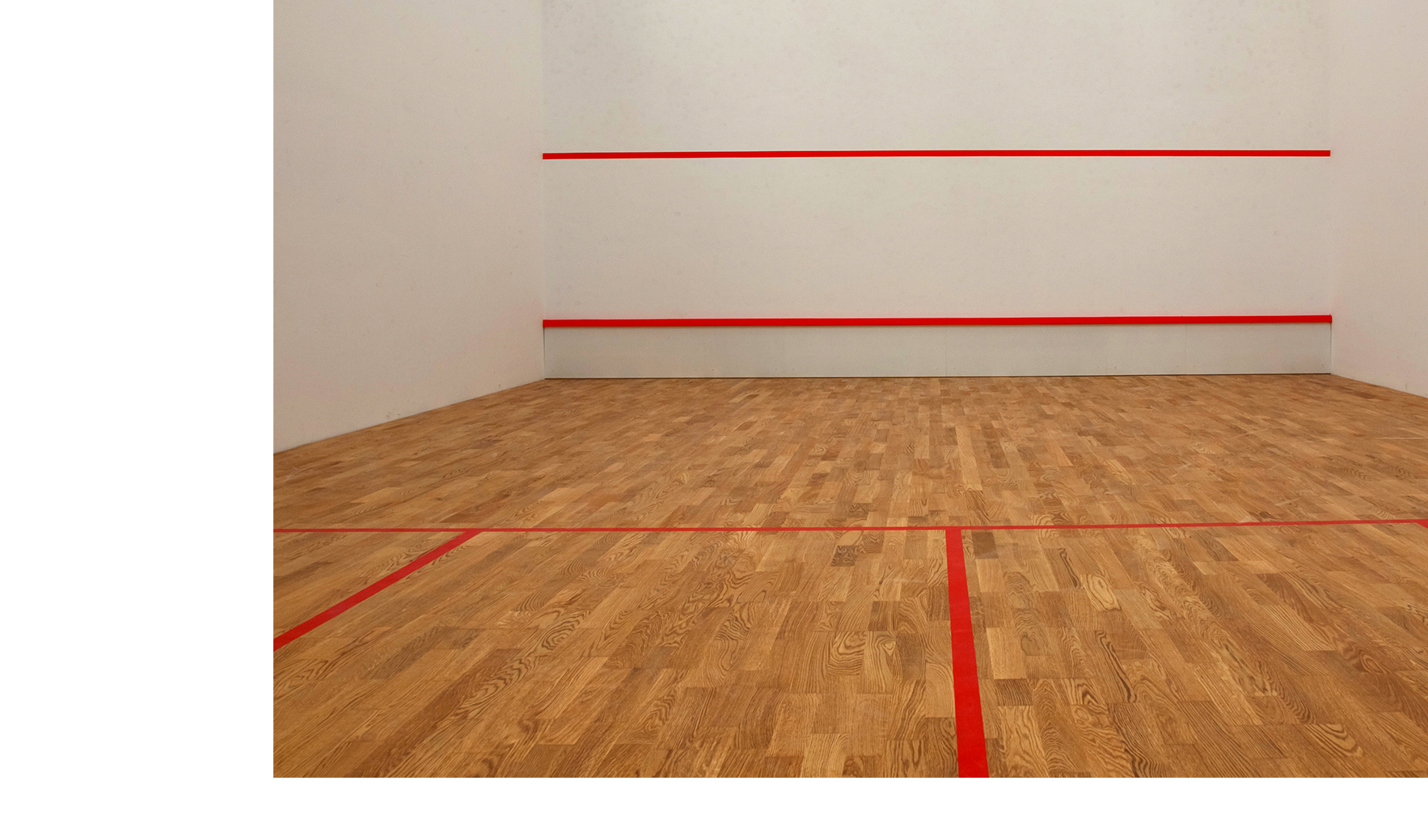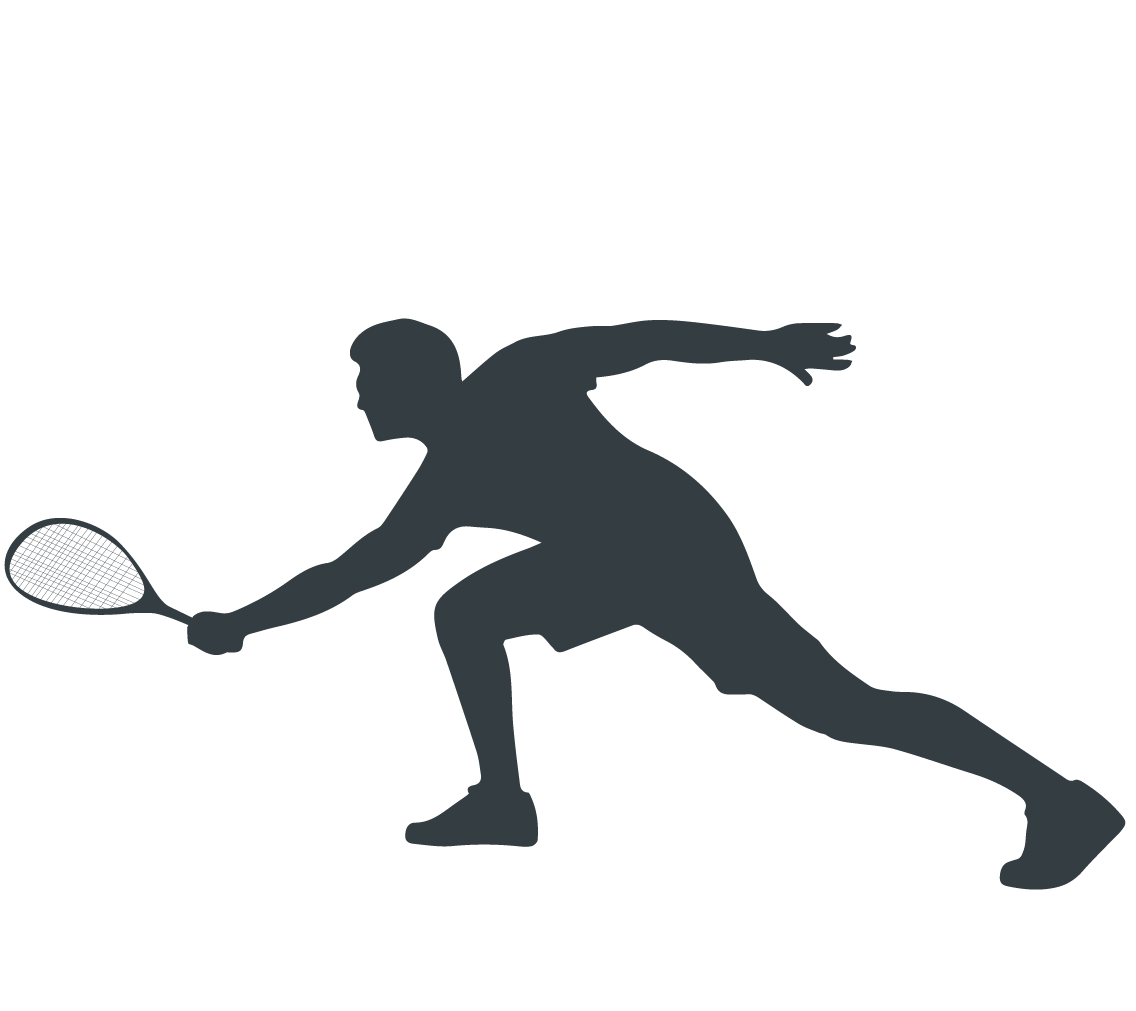The ankle is the most frequently injured body part in squash.

Squash is ball sport played indoors by two or four players, who use a racket to hit a small ball against the walls of the court. While similar to racquetball, the two games use different rackets and balls, and have different court sizes and rules. The sport is played both recreationally and competitively, and is governed locally by Squash BC. Quick shifts in direction can place players at risk of ankle and knee injuries.
(see Section 04 - Prevention)
The ankle is the most frequently injured body part in squash.
The knee is the second most frequently injured body part in squash.
The elbow is the most commonly injured upper extremity in squash.
Lumbar-back injuries caused by overuse can occur from frequent squash participation.
Although not the most frequent squash injury, eye injuries can be very severe, occurring from contact with the squash ball or racket. Lacerations to the head can also occur.
Most squash injuries occur to the lower extremities, followed by the upper extremities and the lower back. Musculoskeletal and non-orthopedic injuries accounted for 64% to 91% of all squash injuries.
It is estimated that...

Novice players sustain two to four times as many squash injuries as advanced players. This may be due to a lack of awareness around the physical demands of the sport, playing too close to their opponent(s), not following the path of the ball, or lack of training in follow-through techniques.
Male players sustain approximately 2.5 times more squash injuries as compared female players, regardless of skill level.
Training and regular practice are expected of athletes, but how much is too much? Your risk of injury can increase if you train too much or improperly. Learn more about how to find your training load “sweet spot.”
Some muscle soreness or joint pain is expected when increasing your level of physical activity. It is important to listen to your body for persistent or worsening pain, and to know when to rest. Learn more about how to prevent injuries in squash.
Talk to your coach or organization, if applicable, about the prevention strategies below and how they might be incorporated into training and policies.
The risk of injury can be reduced by the use of properly fitted personal protective devices, such as eyewear. Check equipment regularly for cracks or other signs of damage.
The risk of all lower body injuries may be reduced by up to 50% by regular participation in a balance training exercise program with a resistance training component, such as a neuromuscular training warm-up program.
Sport Injury Prevention Research Centre Neuromuscular Training
The Sport Injury Prevention Research Centre has developed a neuromuscular training warm-up program that can be adapted to many sports. Incorporating a warm-up program like this one into your training program at least two times per week has been associated with a significant reduction in lower body injuries.
Click here to view poster.
Oslo Sport Trauma Research Centre Neuromuscular Training
Adopt strength training exercises designed to prevent injuries. The Oslo Sport Trauma Research Centre has developed exercises that specifically help reduce the risk of knee and ankle injuries. This resource includes videos and PDFs for download.
Learn more about exercises to help prevent knee injuries.
Learn more about exercises to help prevent ankle injuries.
For more exercises, visit http://fittoplay.org/.
Equipment
Ankle taping can provide support before and after playing squash, and wearing minimalist footwear (lightweight, sock-like shoes) may reduce the force placed on the ankle and knee compared to running shoes.
Safesport – Squash and Racquetball Safety
Safesport (UK) has some information on squash safety.
Sleep, Vigilance and Sport Injury Prevention
Being successful in physical activity requires a high degree of alertness, also known as vigilance. Sufficient sleep helps your body to recover, allows you to achieve your goals, and reduces your risk of injury. Getting less than 8 hours of sleep can increase your rate of injury by up to 70%! Watch this video to learn more about how sleep and vigilance are connected.
Sport-related Physicals
Squash is a physically demanding sport and some pre-existing conditions may increase the risk of injury. An annual sport-related physical evaluation ensuring fitness to play can help to reduce risk of injury. KidsHealth provides information about what sports physicals are, why they may be appropriate and where you may go to get them.
Learn more about Kids Health Sports Physicals.
Talk to your organization or school, if applicable, about the prevention strategies below and how they might be incorporated into training and policies.
The risk of injury can be reduced by the use of properly fitted personal protective devices, such as eyewear. Have your athletes check their equipment regularly for cracks or other signs of damage.
The risk of all lower body injuries may be reduced by up to 50% by regular participation in a balance training exercise program with a resistance training component, such as a neuromuscular training warm-up program.
Sport Injury Prevention Research Centre Neuromuscular Training
The Sport Injury Prevention Research Centre has developed a neuromuscular training warm-up program that can be adapted to many sports. Incorporating a warm-up program like this one into your training program at least two times per week has been associated with a significant reduction in lower body injuries.
Click here to view poster.
Oslo Sport Trauma Research Centre Neuromuscular Training
Adopt strength training exercises designed to prevent injuries. The Oslo Sport Trauma Research Centre has developed exercises that specifically help reduce the risk of knee and ankle injuries. This resource includes videos and PDFs for download.
Learn more about exercises to help prevent knee injuries.
Learn more about exercises to help prevent ankle injuries.
For more exercises, visit http://fittoplay.org/.
Equipment
Ankle taping can provide support before and after playing squash, and wearing minimalist footwear (lightweight, sock-like shoes) may reduce the force placed on the ankle and knee compared to running shoes.
Facilities
The Ontario Physical Education Association (OPHEA) provides recommendations for safely implementing squash in secondary schools.
Learn more about implementing squash in your school.
Safesport – Squash and Racquetball Safety
Safesport (UK) has some information on squash safety.
Sport-related Physicals
Squash is a physically demanding sport and some pre-existing conditions may increase the risk of injury. An annual sport-related physical evaluation ensuring fitness to play can help to reduce risk of injury. KidsHealth provides information about what sports physicals are, why they may be appropriate and where you may go to get them.
Learn more about Kids Health Sports Physicals.
Talk to your coaches, teachers, organization, or school, if applicable, about the prevention strategies below and how they might be incorporated into training and policies.
The risk of injury can be reduced by the use of properly fitted personal protective devices, such as eyewear. Have your athletes check their equipment regularly for cracks or other signs of damage.
The risk of all lower body injuries may be reduced by up to 50% by regular participation in a balance training exercise program with a resistance training component, such as a neuromuscular training warm-up program.
Sport Injury Prevention Research Centre Neuromuscular Training
The Sport Injury Prevention Research Centre has developed a neuromuscular training warm-up program that can be adapted to many sports. Incorporating a warm-up program like this one into your training program at least two times per week has been associated with a significant reduction in lower body injuries.
Click here to view poster.
Oslo Sport Trauma Research Centre Neuromuscular Training
Adopt strength training exercises designed to prevent injuries. The Oslo Sport Trauma Research Centre has developed exercises that specifically help reduce the risk of knee and ankle injuries. This resource includes videos and PDFs for download.
Learn more about exercises to help prevent knee injuries.
Learn more about exercises to help prevent ankle injuries.
For more exercises, visit http://fittoplay.org/.
Equipment
Ankle taping can provide support before and after playing squash, and wearing minimalist footwear (lightweight, sock-like shoes) may reduce the force placed on the ankle and knee compared to running shoes.
In Australia, the Protective Eyewear Promotion (PEP) program is an educational strategy that increases the use of appropriate protective eyewear by squash players. The program involves providing eyewear for players to try out and purchase, as well as displaying educational pamphlets, posters, and stickers at suitable venues such as the registration desk, near the squash courts, and changing rooms. Consider a PEP initiative or similar program in your facility.
Facilities
The Ontario Physical Education Association (OPHEA) provides recommendations for safely implementing squash in secondary schools.
Learn more about implementing squash in your school.
Safesport – Squash and Racquetball Safety
Safesport (UK) has some information on squash safety.
Sport-related Physicals
Squash is a physically demanding sport and some pre-existing conditions may increase the risk of injury. An annual sport-related physical evaluation ensuring fitness to play can help to reduce risk of injury. KidsHealth provides information about what sports physicals are, why they may be appropriate and where you may go to get them.
Learn more about Kids Health Sports Physicals.
The role of health professionals in preventing squash injuries has two main components:
The risk of injury can be reduced by the use of properly fitted personal protective devices, such as eyewear. Encourage athletes check their equipment regularly for cracks or other signs of damage.
The risk of all lower body injuries may be reduced by up to 50% by regular participation in a balance training exercise program with a resistance training component, such as a neuromuscular training warm-up program.
Sport Injury Prevention Research Centre Neuromuscular Training
The Sport Injury Prevention Research Centre has developed a neuromuscular training warm-up program that can be adapted to many sports. Incorporating a warm-up program like this one into your training program at least two times per week has been associated with a significant reduction in lower body injuries.
Click here to view poster.
Oslo Sport Trauma Research Centre Neuromuscular Training
The Oslo Sport Trauma Research Centre has developed exercises that specifically reduce the risk of knee and ankle injuries. This resource includes videos and PDFs for download.
Learn more about exercises to help prevent knee injuries.
Learn more about exercises to help prevent ankle injuries.
For more exercises, visit http://fittoplay.org/.
Equipment
Ankle taping can provide support before and after playing squash, and wearing minimalist footwear (lightweight, sock-like shoes) may reduce the force placed on the ankle and knee compared to running shoes.
Sport-related Physicals
Squash is a physically demanding sport and some pre-existing conditions may increase the risk of injury. An annual sport-related physical evaluation ensuring fitness to play can help to reduce risk of injury. The American Academy of Pediatrics provides information about preparticipation physical evaluation.
Learn more about Preparticipation Physical Evaluation.
Safesport – Squash and Racquetball Safety
Safesport (UK) has some information on squash safety.
